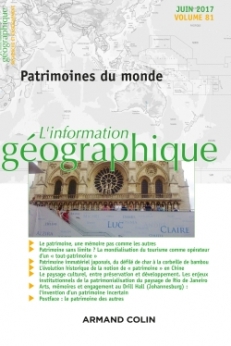
L'information géographique (2/2017)
Pour acheter ce numéro, contactez-nous
Recevez les numéros de l'année en cours et accédez à l'intégralité des articles en ligne.
Site patrimonial du centre-ville de Johannesburg (Afrique du Sud), le Drill Hall est peu entretenu par les institutions publiques mais fortement approprié par des associations artistiques, culturelles et sociales. Dans cette tension entre une patrimonialisation institutionnelle faible et la vivacité des mémoires, ce lieu apparaît comme un espace interstitiel en attente de son destin institutionnel. En quoi, les artistes correspondent-ils à des figures de l’engagement ? Dans quelle mesure les discours des artistes constituent-ils un vecteur de patrimonialisation et un argument de légitimation de leur présence ? Nous montrerons que cet engagement artistique et mémoriel contribue à l’invention d’un rapport inédit à l’art et au patrimoine, mais dont la capacité de résistance aux projets de rénovations urbaines et plus encore à la gentrification est pour le moins incertaine.
The Drill Hall is a heritage site in the inner city of Johannesburg (South Africa). It is poorly maintained by public authorities but highly appropriates by artistic, cultural and social organizations. Because of this tension between a low institutional heritagization of the site and the vividness of the people’s memories attached to it, the Drill Hall appears as an interstitial space, awaiting his institutional fate. To what extent the artists form figures of commitment on one side, and culture constitute a ground for conflict and transmission of the memories on the other side ? How the artists’ discourses are a catalyst for heritagization as well as an argument that allows them to legitimize their presence in this place ? We will argue that this commitment toward art and memory contributes to the invention of a new relationship to art and heritage, but whose capacity to fight against the dynamics of urban regeneration, if not gentrification, is far from certain.

